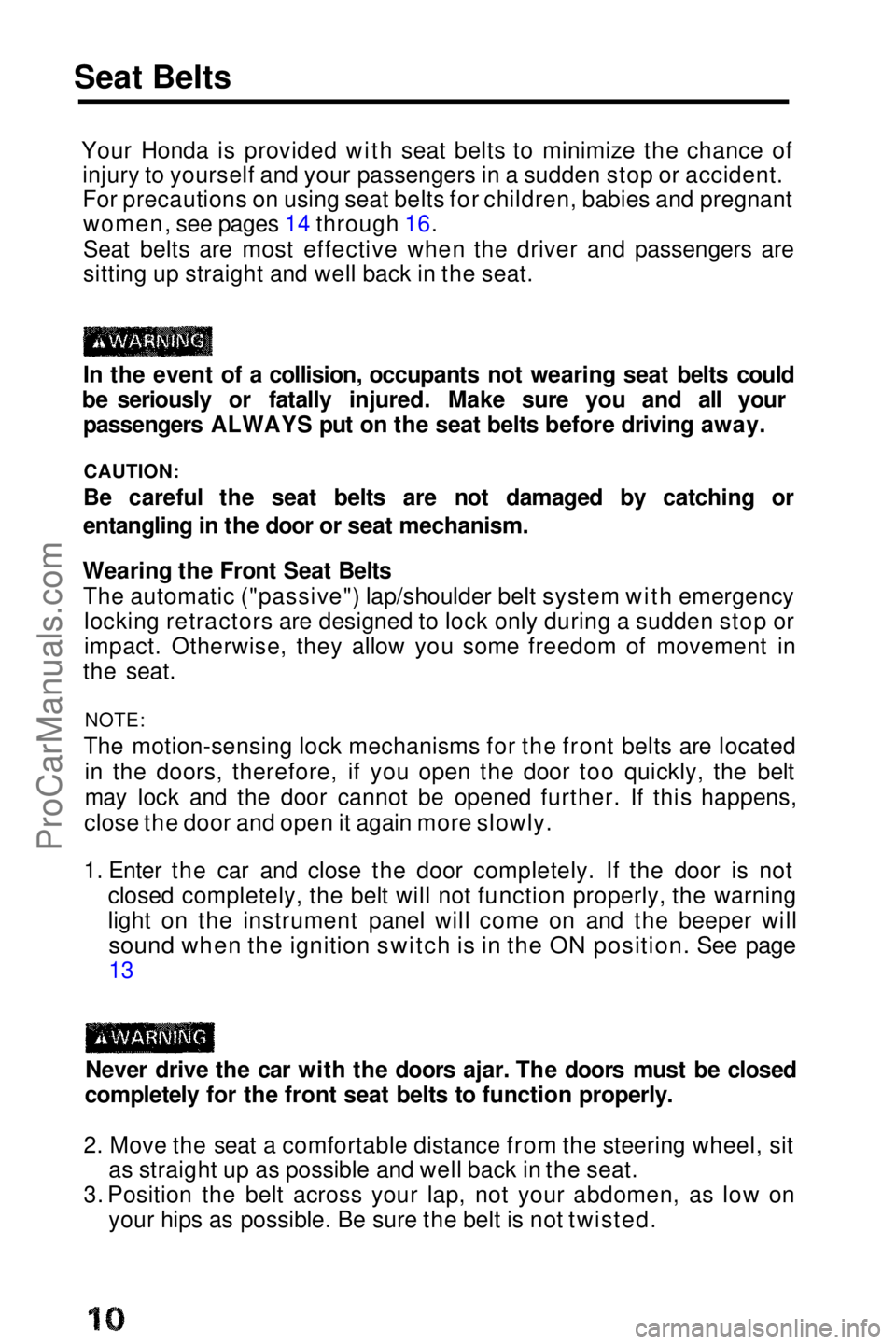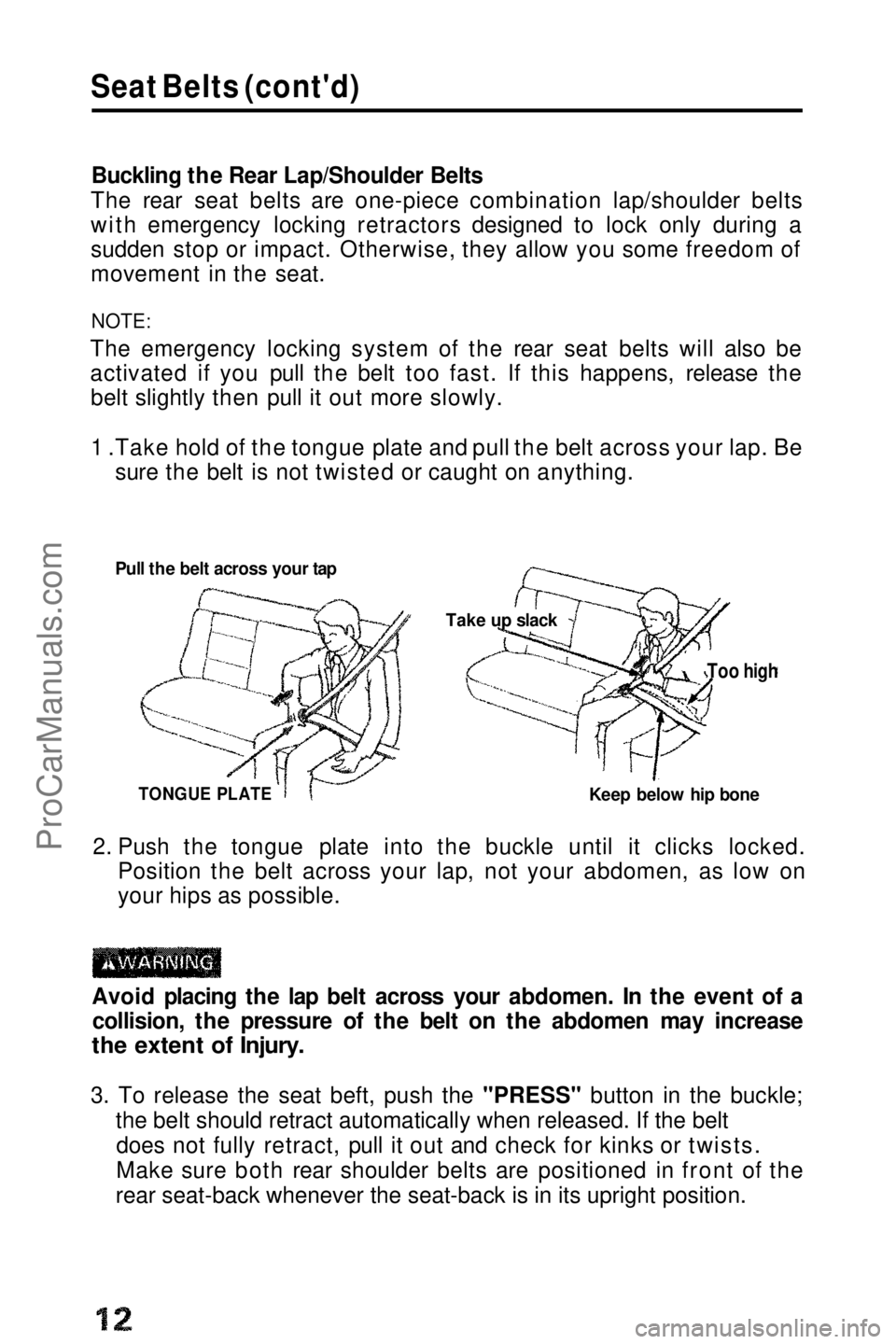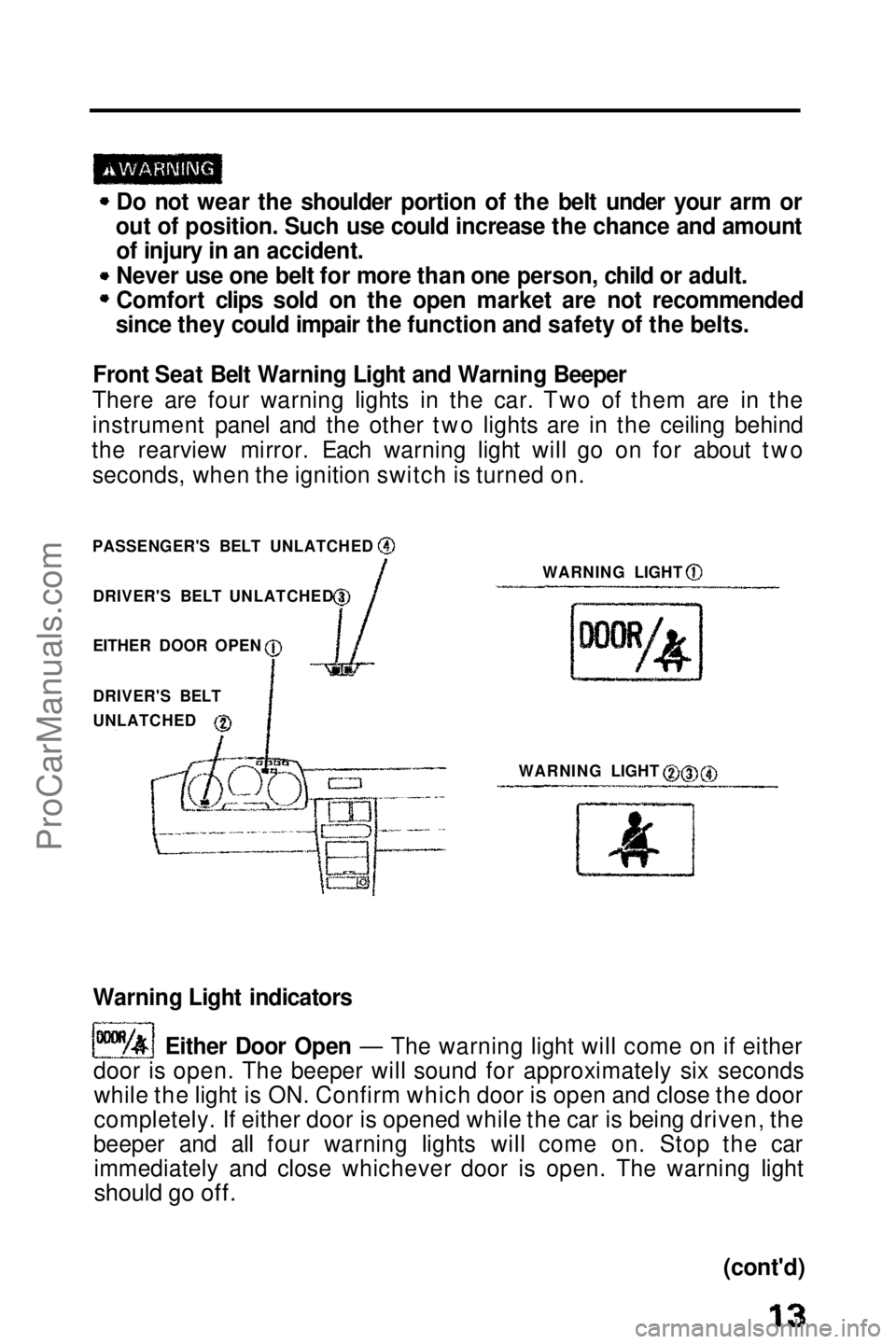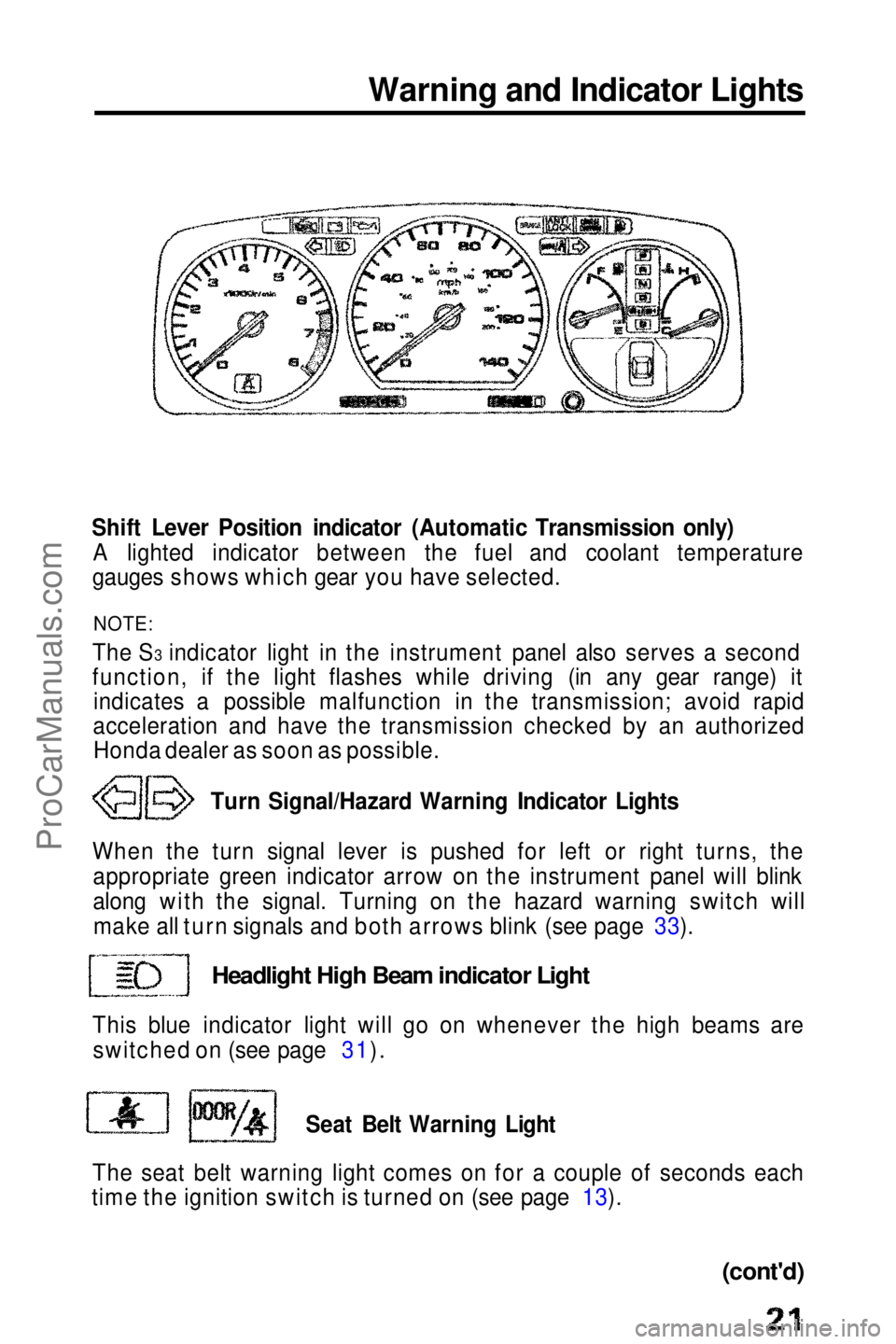1990 HONDA PRELUDE light
[x] Cancel search: lightPage 10 of 143

Seat Belts
Your Honda is provided with seat belts to minimize the chance ofinjury to yourself and your passengers in a sudden stop or accident.
For precautions on using seat belts for children, babies and pregnantwomen, see pages 14 through 16.
Seat belts are most effective when the driver and passengers are
sitting up straight and well back in the seat.
In the event of a collision, occupants not wearing seat belts could
be seriously or fatally injured. Make sure you and all your passengers ALWAYS put on the seat belts before driving away.
CAUTION:
Be careful the seat belts are not damaged by catching or
entangling in the door or seat mechanism.
Wearing the Front Seat Belts The automatic ("passive") lap/shoulder belt system with emergency locking retractors are designed to lock only during a sudden stop or
impact. Otherwise, they allow you some freedom of movement in
the seat.
NOTE:
The motion-sensing lock mechanisms for the front belts are located in the doors, therefore, if you open the door too quickly, the belt
may lock and the door cannot be opened further. If this happens,
close the door and open it again more slowly.
1. Enter the car and close the door completely. If the door is not closed completely, the belt will not function properly, the warning
light on the instrument panel will come on and the beeper will
sound when the ignition switch is in the ON position. See page
13
Never drive the car with the doors ajar. The doors must be closed
completely for the front seat belts to function properly.
2. Move the seat a comfortable distance from the steering wheel, sit as straight up as possible and well back in the seat.
3. Position the belt across your lap, not your abdomen, as low on your hips as possible. Be sure the belt is not twisted.ProCarManuals.comMain Menu t s
Page 12 of 143

Seat Belts (cont'd)
Buckling the Rear Lap/Shoulder Belts
The rear seat belts are one-piece combination lap/shoulder belts
with emergency locking retractors designed to lock only during a
sudden stop or impact. Otherwise, they allow you some freedom of
movement in the seat.
NOTE:
The emergency locking system of the rear seat belts will also be
activated if you pull the belt too fast. If this happens, release the belt slightly then pull it out more slowly.
1 .Take hold of the tongue plate and pull the belt across your lap. Be sure the belt is not twisted or caught on anything.
Pull the belt across your tap
2. Push the tongue plate into the buckle until it clicks locked. Position the belt across your lap, not your abdomen, as low on
your hips as possible.
Avoid placing the lap belt across your abdomen. In the event of a collision, the pressure of the belt on the abdomen may increase
the extent of Injury.
3. To release the seat beft, push the "PRESS" button in the buckle;
the belt should retract automatically when released. If the belt
does no
t fully retract, pull it out and check for kinks or twists.
Make sure both rear shoulder belts are positioned in front of the
rear seat-back whenever the seat-back is in its upright position.
Too high
Keep below hip bone
Take up slack
TONGUE PLATEProCarManuals.comMain Menu t s
Page 13 of 143

Do not wear the shoulder portion of the belt under your arm or
out of position. Such use could increase the chance and amount of injury in an accident.
Never use one belt for more than one person, child or adult.
Comfort clips sold on the open market are not recommended
since they could impair the function and safety of the belts.
Front Seat Belt Warning Light and Warning Beeper
There are four warning lights in the car. Two of them are in the
instrument panel and the other two lights are in the ceiling behind
the rearview mirror. Each warning light will go on for about two seconds, when the ignition switch is turned on.
WARNING LIGHT
WARNING LIGHT
Warning Light indicators Either Door Open — The warning light will come on if either
door is open. The beeper will sound for approximately six seconds while the light is ON. Confirm which door is open and close the door
completely. If either door is opened while the car is being driven, the
beeper and all four warning lights will come on. Stop the car immediately and close whichever door is open. The warning light
should go off.
(cont'd)
PASSENGER'S BELT UNLATCHED
DRIVER'S BELT UNLATCHED
EITHER DOOR OPEN
DRIVER'S BELT
UNLATCHEDProCarManuals.comMain Menu t s
Page 14 of 143

Seat Belts (cont'd)
Driver's Belt Unlatched — The warning lights will come on if
the driver's seat belt is not latched. The beeper will sound for approximately six seconds while the light is ON, Relatch the belt;
the light should go off.
Front Passenger's Belt Unlatched — The warning light will
come on if the passenger's belt is not securely latched, the beeper
will sound for approximately six seconds. Relatch the belt; the light
should go off.
If the lights and beeper do not function at all or if they come on
even with the belts latched and doors fully closed, it indicates a
malfunction in the seat belt system. In the event of a collision,
severe personal injury could result. The system should be checked immediately by an authorized Honda dealer.
Child Restraint
Children riding in the car should be restrained to minimize the risk ofinjury in an accident, sudden stop or sudden maneuver.
According to accident statistics provided to the National Highway
Traffic Safety Administration (NHTSA), children are safer when properly restrained in the rear seating positions than in the front
seat Larger children should use one of the seat belts provided. For smaller children, we strongly recommend the use of a
commercially available child restraint system that meets the Federal Motor Vehicle Safety Standard (FMVSS) because it offers the most protection against injury. All states now have laws which require
that small children must be seated in a child passenger seat restraint system. Check local laws.
Before buying a particular child restraint system, make sure it fits
your car seat and seat belts, and fits your child. Follow all the
instructions that come with the system.ProCarManuals.comMain Menu t s
Page 18 of 143

ALB (Anti Lock Brakes) help to maintain the road holding and
tractability of your car during severe braking, and under slippery road conditions. The ALB system prevents the wheels from locking(thus reducing the chance of skidding) to ensure controllable
deceleration. When sudden braking might otherwise lock one or more wheels, the ALB system temporarily reduces the braking
pressure to the wheel or wheels about to lock to ensure continued
braking efficiency.
When the ALB is regulating the braking pressure, the brake pedal pulsates slightly to make the driver aware that the system is
compensating for critical braking conditions. The pulsating brake pedal can be an indication of hazardous road condition, and to
remind you to take extra care.
Don't mix different diameter tires; it will confuse the ALB
computer which monitors the road speed of each wheel. For
example, if one or more tires are larger than the others, the computer will think they are rolling more slowly (as if they are
about to lock up) and reduce brake pressure to those wheels.On loose or uneven surfaces (gravel, ruts etc.) where all four
wheels loss traction intermittently, the ALB system may require
a longer stopping distance than an equivalent car with a conventional braking system.
The ALB system cannot make up for extreme road conditions or driver misjudgement, It is still the driver's responsibility to drive
at a suitable speed and provide a margin of safety for the road,
weather and traffic conditions at hand.
CAUTION:
Be careful not to damage the wiring or the speed sensors at the
back of each wheel when removing mud or snow from the wheel
housings.
NOTE:
You may hear a sound like a small motor running, coming from the engine while driving or after the ALB is applied. This indicates theALB pump is in service and the system is working properly.
Ant
i
Lock Brake (Si with ALB)
ProCarManuals.comMain Menu t s
Page 19 of 143

Instrument Panel
TURN SIGNAL/ LIGHT SWITCH/
DIMMER SWITCH
SUNROOFSWITCH
HEADLIGHT
MOTOR
SWITCH PANEL BRIGHTNESS
CONTROL KNOB HAZARD WARNING
LIGHT SWITCH
FOG LAMP
SWITCH REAR WINDOW
DEFOGGER
SWITCH
DIGITAL
CLOCK
CENTER
VENTS
CRUISE
CONTROL
MASTER
SWITCH
FUSE BOX COIN BOX
HORN
BUTTON WINDSHIELD
WIPER/WASHER
SWITCH LEVER
IGNITION SWITCH CIGARETTE
LIGHTER
HEATING/
COOLING
CONTROL
PANEL
TACHOMETER SPEEDOMETER
FUEL GAUGESHIFT LEVER
POSITION
INDICATOR
(AUTOMATIC)
ODOMETER TRIP METER
TRIP METERRESET BUTTON SAFETY
INDICATOR
LIGHT
COOLANT
TEMPERATURE
GAUGEProCarManuals.comMain Menu t s
Page 21 of 143

Warning and Indicator Lights
Shift Lever Position indicator (Automatic Transmission only) A lighted indicator between the fuel and coolant temperature
gauges shows which gear you have selected.
NOTE:
The S3 indicator light in the instrument panel also serves a second
function, if the light flashes while driving (in any gear range) it indicates a possible malfunction in the transmission; avoid rapid
acceleration and have the transmission checked by an authorized Honda dealer as soon as possible.
Turn Signal/Hazard Warning Indicator Lights
When the turn signal lever is pushed for left or right turns, the appropriate green indicator arrow on the instrument panel will blink
along with the signal. Turning on the hazard warning switch willmake all turn signals and both arrows blink (see page 33).
Headlight High Beam indicator Light
This blue indicator light will go on whenever the high beams are switched on (see page 31).
Seat Belt Warning Light
The seat belt warning light comes on for a couple of seconds each
time the ignition switch is turned on (see page 13).
(cont'd)ProCarManuals.comMain Menu t s
Page 22 of 143

Warning and Indicator Lights (cont'd)
Oil Pressure Warning Light
A severe fluctuation in engine oil pressure will cause this light to
flash on and off. You should stop as soon as possible, check the oil level, and add oil if necessary.
The oil pressure warning light will come on, and remain on, if there is insufficient oil pressure or when the ignition switch is turned on
with the engine not running. If the light should stay on while driving,
get the car off the road as soon as you can, turn the engine off and
check the engine oil level (see page 83).
Even if the oil level is correct, the engine should be checked by a
Honda dealer before the car is driven again.
NOTE:
The oil pressure warning light will only light as a result of low oil pressure. It is not directly an oil level indicator.
CAUTION:
Running the engine while the oil pressure warning light is on
constantly may cause immediate and severe engine damage.
Cruise Control Indicator Light
When the cruise control system is on, this indicator light is on (see
page 35 and 36).
Fuel Reserve Warning Light
If the warning light glows, it means you should refuel, because the
tank contains less than:
10 l (2.6 US gal, 2.2 Imp gal) CRUISE
CONTROLProCarManuals.comMain Menu t s